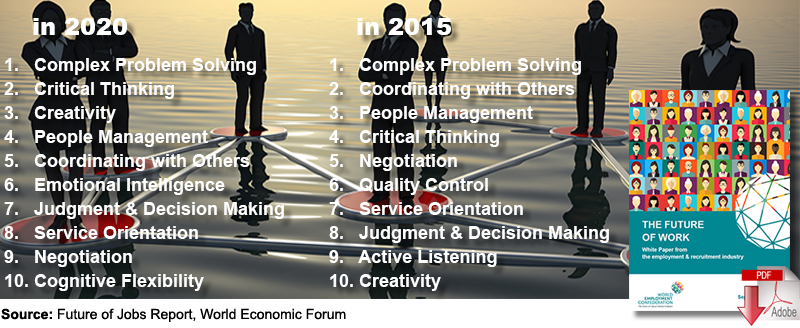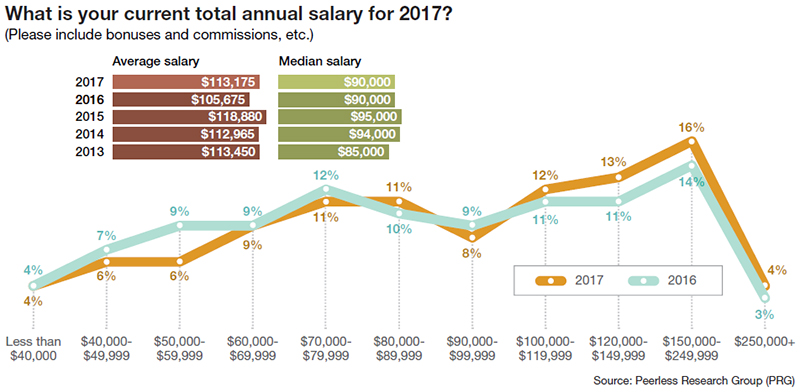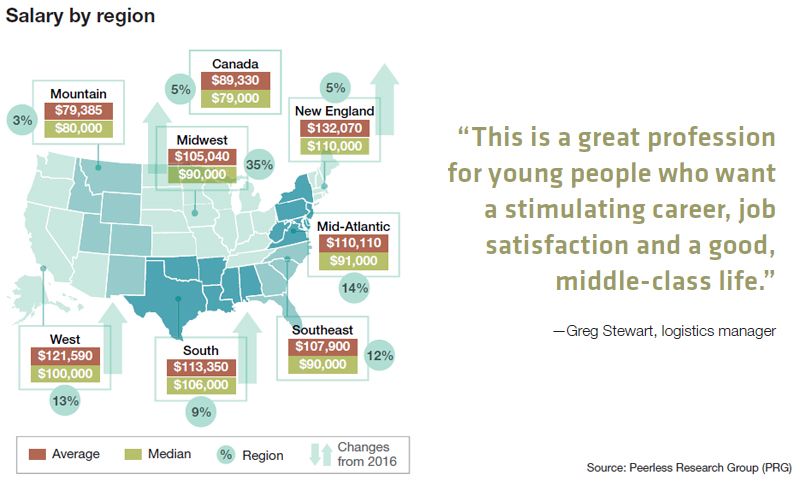Logistics Management 33rd Annual Salary Survey

Logistics Management's “33rd Annual Salary Survey” reflects more diversity entering the logistics management market, and in marked contrast to 2016, paints a rosier outlook for career placement and advancement.
According to the findings of “Logistics Management’s 33rd Annual Salary Survey,” new demands facing logistics managers this year are again driven by the continued double-digit growth of e-commerce.
As a consequence, salaries are set to match the complex skill sets needed to make companies competitive in this highly dynamic marketplace.
In other high-level findings, our Peerless Research Group (PRG) also notes that professionals are being lured by logistics jobs that are providing a better standard of living in regions where new concentrations of e-commerce are being created.
And while news has surfaced recently about the limited opportunities for women in the high-tech industry, just the opposite seems to be happening in logistics management.
Our research also indicates that there has never been a better time for women to choose this career path.
Overall, a slight bump
And while much of the findings pulled from this year’s data indicate a movement toward the need for a younger, more diverse mix, we did find that aggregate salaries inched up glacially last year, with middle-aged managers still earning more than their younger peers.
However, after age 55 those earnings plateau, and we’re seeing more “boomers” consider retirement.
Enter the young guns, who demand and expect better compensation for delivering solutions driven by digitized supply chains.
In the meantime, peak 2017 median salaries remained at $90,000, matching last year’s number, with managers at all levels reporting cost-of-living raises.
However, those survey respondents who have only been in their present position for 3 years to 5 years - the highest percentage of those questioned - captured the greatest gains in income, rising to $97,000 from $87,000 over just the past 12 months.
“It’s interesting to note that logistics managers with the most expertise in e-commerce strategies are still the highest paid,” says PRG research director Judd Aschenbrand.
In fact, those survey respondents who say that they’re “highly knowledgeable” about e-commerce are bringing in a median salary of $105,000 compared to the $73,500 earned by those who say they are on the low end of the learning curve.
“This is a trend we first tracked last year, indicating that younger workers might be better positioned for advancement, as they tend to be more comfortable with digitized commerce,” adds Aschenbrand.
But while attracting young talent to logistics seems to be gaining traction, retaining them may be another matter. Unlike older generations, workers in their 20s and 30s tend to keep looking for better offers more frequently - and it’s not just about money, say their veteran managers.
Young people are searching for a finer balance between their careers and personal lives, and want their jobs to have “meaning.”
Those survey respondents in the $95,000 per-year median range represent the 43% who “are always looking for better opportunities.”
Another important observation made by PRG researchers was the growing influence of social networking for younger workers negotiating compensation. This particular skill was judged as “very important” by 40% of our respondents - up from 29% just a year ago.
Just before the soaring bull market took off after the Presidential election last November, salaries were still rising from $80,000 to $85,000 for managers working for privately-held companies. Should economic indicators like job growth and consumer confidence continue to gain wind, logistics managers in the private sector are likely to be even more optimistic in the future.
Millenials looking for “balance”
Greg Stewart is on what he calls “the backside” of his career. Having worked for a trucking company before spending more than a decade with Wal-mart, he’s now the logistics manager for Red Dakota Corp., a privately held company in Cedar Rapids, Iowa, specializing in ready-mixed concrete manufacturing and distribution.
“I have been with just three companies throughout my career - which is not unusual for my generation,” says Stewart. “But young people tend to move around a lot more.” However, he doesn’t believe that seeking higher compensation is the catalyst for those frequent moves.
According to Stewart, Millennials want greater balance in their lives, while many are unwilling to chase six-figure salaries if they must sacrifice time with their friends and families. “This is a great profession for young people who want a stimulating career, job satisfaction and a good, middle-class life,” he says.
Candy Snyder, an operations and logistics manager for a small consumer manufacturing company in New Hampshire, is also in the late stage of her career, having worked of just a handful of companies earlier.
“Years ago, there was more company loyalty,” says Snyder. “But today, young people tend to change jobs more frequently. You can’t blame them, though. The world has changed, and the security blanket is no longer there for them stay in one place.”
Greener pastures in the Midwest
Looking for greener pastures may mean making a move to the U.S. Midwest, our research shows. Logistics managers in this region saw a spike in median salaries go from $81,000 last year to $90,000 in 2017. Also worth noting is that the highest percentage of survey respondents (35%) come from these states.
Our findings certainly mirror recent research done by the industrial real estate firm Jones Lang LaSalle (JLL) that found a hotbed of e-commerce fulfillment being created in Indianapolis, Columbus, Cincinnati and St. Louis over the past 24 months.
In a nutshell, the JLL research links the shortage of DC labor in the United States to growth in DC leasing/construction activity in what are considered by JLL to be “secondary” Midwestern markets.
“These findings on logistics-related job growth in that region were not much of a surprise,” says Walter Kemmsies, Ph.D., JLL’s managing director, economist and chief strategist. “Given the fact that more goods must be held in more locations in these markets, we expect to see a shift in logistics to the Midwest.”
Matt Powers, JLL’s vice president of retail e-commerce, agrees, and shared this observation on our Midwest wage data: “There’s been a ‘ripple effect’ in compensation for logistics managers in the region. And as lower-wage workers are becoming better paid, those in management are expecting to earn more, too.”
Women in logistics
For the first time, PRG used our “Salary Survey” platform to begin taking a more detailed look at how women are competing in the logistics management profession. A close reading of our findings reveals the following:
- More women are likely to be involved with import/export operations.
- Women say the number of functions in their job has increased over the past 2 years to 3 years.
- More women than men are planning to take continuing education programs or classes during the next 12 months because they believe a class or program will lead them to earn a better salary.
- A greater ratio of women believe that there are advancement opportunities.
- Women are more likely to find job fairs, trade media and social media helpful in learning more about opportunities for better paying jobs in the logistics management marketplace.
At the same time, say PRG researchers, there’s considerable data suggesting that women appear more dissatisfied with lack of recognition and promotion to leadership positions - a conclusion echoed in a recent interview with a prominent executive recruiter (see sidebar below).
Finally, and as we’ve found in years past, our research discovered that money isn’t everything. “Feeling of accomplishment” (55%) and “relationship with colleagues” (52%) were again judged to be more important than salary (47%).
This explains in large part why 83% are recommending this career path to a son, daughter or friend, and why another whopping 84% expect to see younger logistics managers entering the workforce.
Read the SC24/7 Article: Robert Walters 2017 Global Salary Survey Trends
Women Leaning Into Logistics
The vital role women play in the logistics management community gains traction every year, maintains Tisha Danehl, vice president of Ajilon, a national professional staffing agency serving the supply chain and logistics industries.
In an exclusive interview with Logistics Management, she shares her forecast and observations.
Where do you see the greatest growth for women in logistics?
I see tremendous room for growth for women in logistics leadership roles. While recent college graduates are continuing to enter the industry, the climb to the top of the corporate ladder remains challenging for women.
Women account for 37% of students enrolled in university supply chain courses, according to SCM World’s recent poll of global universities, yet just 5% of top-level supply chain positions at Fortune 500 companies are filled by women - that’s compared to 15% of other executive officer positions at the same organizations.
So, they’re underrepresented in logistics management?
Yes, that’s right. While women may be underrepresented in these management roles, there are certainly opportunities for them.
In a report co-published by Gartner and AWESOME, a non-profit organization dedicated to advancing women’s leadership in supply chain, researchers note that two ways companies can offset the gender imbalance include: filling the pipeline with more women in entry-level logistics management positions, and focusing on leadership development programs that ensure women are being actively considered, sponsored and advanced.
So, how do logistics managers take advantage of this trend?
To successfully create a diverse workforce, it’s important that companies offer benefits and initiatives that can help attract and retain more women, such as flex-time, mentorships, on-the-job training opportunities and competitive salaries.
In what regions of the U.S. are you seeing that growth for logistics jobs for women?
According to the Bureau of Labor Statistics (BLS), employment for logisticians is projected to grow 2% between 2014 and 2024. This growth is being driven by the need for logistics in the transportation of goods in a global economy. We’re seeing growth throughout the U.S. within the industry. The BLS reports that the states with the highest employment level for women logisticians include California, Texas, Michigan, Virginia and Ohio.
Do you have any advice for women on how to break into the industry?
An ideal place to start is to get a degree in supply chain and logistics. There are over 150 bachelor programs now available that will set you up for a successful career in the industry. Many companies now partner with universities to recruit college graduates directly.
What about internships for women?
Good question. We encourage female students interested in the supply chain and logistics field to pursue internship opportunities as early as possible in order to gain a competitive edge over other job seekers once they graduate. It’s also a good idea to explore industry networking groups to meet new people with the experience you are seeking who are willing to help connect others.
Many universities offer these types of groups through their alumni programs. There are also a number of groups you can join online through LinkedIn, such as Logistics and Supply Chain Professionals.
Related White Papers: Logistics & Supply Chain Talent
Professionals New Perspectives - 2017 Salary Guide
Get the most up-to-date salary data for your local job market and around the country, plus the latest job descriptions and industry insights-from the experts in staffing and recruiting top specialty talent. Download Now!
Are You Prepared For The Supply Chain Talent Crisis?
The industry can build an adequate supply of talent in a number of ways, but companies must be more proactive in their approach to recruiting, developing, and retaining the supply chain professionals they need to stay competitive. Download Now!
Survey Analysis: Women in Supply Chain Survey, 2016
Gartner's first Women in Supply Chain Survey, conducted with AWESOME, an executive women's leadership group, compares the representation of women in supply chain leadership roles, it also identifies practices that are increasing the engagement with and success of women in supply chain organizations. Download Now!
Diversity Matters
McKinsey has been examining diversity in the workplace for several years, our latest report, Diversity Matters, examined proprietary data sets for 366 public companies across a range of industries in Canada, Latin America, the United Kingdom, and the United States. Download Now!
How Leadership Training can Improve Company Culture
When training leaders it is important for leaders to know they need to ask for feedback as often as they give it, the result is the ability for any employee at any level to be able to raise an issue as soon as it arises without fear the recipient will not be open to receiving the information. Download Now!
Robert Walters 2017 Global Salary Survey
This annual Global Salary Survey covers the UK and Ireland, Continental Europe, the Middle East, Africa, Asia, Australia and New Zealand as well as North and South America. Download Now!
Top 10 Skills (Future of Jobs Report, World Economic Forum)

Download the White Paper: The Future of Work
Article Topics
Ajilon News & Resources
Women In The Supply Chain: How Far Have We Come? Logistics Management 33rd Annual Salary Survey Professionals New Perspectives - 2017 Salary Guide High Demand for Supply Chain Professionals in the Manufacturing and Retail IndustriesLatest in Supply Chain
U.S. Manufacturing Gains Momentum After Another Strong Month Biden Gives Samsung $6.4 Billion For Texas Semiconductor Plants Apple Overtaken as World’s Largest Phone Seller Frictionless Videocast: The Importance of Water at the U.S./Mexico Border with Commissioner Maria-Elena Giner, International Boundary and Water Commission Why are Diesel Prices Climbing Back Over $4 a Gallon? Walmart Unleashes Autonomous Lift Trucks at Four High-Tech DCs Plastic Pollution is a Problem Many Companies are Still Ignoring More Supply ChainAbout the Author



























